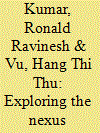|
|
|
Sort Order |
|
|
|
Items / Page
|
|
|
|
|
|
|
| Srl | Item |
| 1 |
ID:
125828


|
|
|
|
|
| Publication |
2013.
|
| Summary/Abstract |
The paper investigates the long-run cointegration relationship and energy elasticities for Kenya and South Africa over the periods 1978-2009 and 1971-2009, respectively, using the ARDL procedure developed by Pesaran et al. (2001) with recomputed critical bounds from Narayan (2005) and the Solow (1956) framework extended by Rao (2010). We also conduct the (Toda and Yamamoto (1995) test for Granger non-causality. The regression results show that short-run and long-run energy elasticities are 0.50 and 1.71, respectively for Kenya and 0.17 and 0.34, respectively for South Africa. The causality results indicate a unidirectional Granger causality running from capital per worker and energy per capita to output per worker for both countries. Moreover, in Kenya, we detect a strong unidirectional causality: (a) on output from joint consideration of capital stock and energy; and (b) on capital stock from joint consideration of energy and output. In South Africa, the joint causations are neutral. Hence, while energy and capital stock spurs growth in both countries, Kenya has a greater potential to harness growth and capital productivity via joint consideration of energy with capital and output, respectively.
|
|
|
|
|
|
|
|
|
|
|
|
|
|
|
|
| 2 |
ID:
132691


|
|
|
|
|
| Publication |
2014.
|
| Summary/Abstract |
In this article, we explore the long-run cointegration between output, capital and energy consumption, in per worker terms, for Albania, Bulgaria, Hungary and Romania. We use the augmented Solow (1956) model and the ARDL bounds procedure (Pesaran et al., 2001) to examine the short-run and long-run effects of energy and capital on output (in per worker terms). We also conduct causality test using the Toda and Yamamoto (1995) non-causality procedure. Our results show the existence of long-run cointegration between output per worker and energy per worker for all the four countries. We find that energy per worker have a dynamic short-run positive effect in Albania (0.37%), Bulgaria (0.25%), Hungary (0.36%) and Romania (0.68%), and a long-run positive effect in Bulgaria (0.32%) and Romania (0.63%) which duly indicate that energy consumption has a momentous long-run effect in these two countries. The causality results indicate a unidirectional causation from output per worker to energy per worker for all the four countries, and from capital per worker to energy per worker for Albania and Romania. Consequently, a balance between effective energy consumption and sound energy conservation policies are likely to support economic growth in the four countries.
|
|
|
|
|
|
|
|
|
|
|
|
|
|
|
|
| 3 |
ID:
130055


|
|
|
|
|
| Publication |
2014.
|
| Summary/Abstract |
In this article, we explore the nexus between information and communications technology (ICT), remittances and output per worker in Vietnam from 1980 to 2012. Within the augmented Solow framework, we deploy the autoregressive distributed lag bounds procedure and Granger causality tests to examine the short-run and long-run effects and the direction of causality, respectively. The results show that ICT has a momentous short-run (0.002 per cent) and long-run (0.006 per cent) effect on per worker output. However, in the long run, the elasticity coefficient of remittances is positive but not significant within the 1-10 per cent level of significance, and the short-run results show mixed effects. The causality result indicates bidirectional causation between remittances and output per worker, duly emphasizing their mutually reinforcing effect and a unidirectional causation from capital per worker and ICT to remittances, respectively.
|
|
|
|
|
|
|
|
|
|
|
|
|
|
|
|
|
|
|
|
|